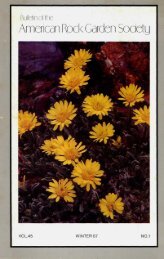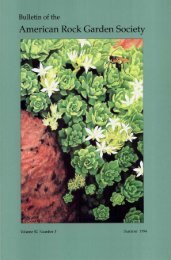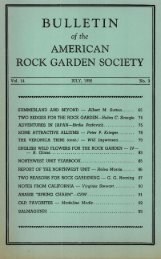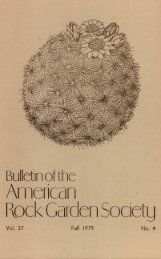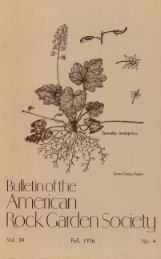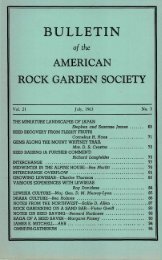Bulletin - Summer 1979 - North American Rock Garden Society
Bulletin - Summer 1979 - North American Rock Garden Society
Bulletin - Summer 1979 - North American Rock Garden Society
You also want an ePaper? Increase the reach of your titles
YUMPU automatically turns print PDFs into web optimized ePapers that Google loves.
from a "wildflower nursery" — thatmeans usually plants collected in thewild — some tubers of Squirrel Corn.These I put in a nearby spot undersome Kaempferi Azaleas. For a yearor two there were a few sprigs ofdicentra foliage and no real displayof blossoms, so I tried moving a fewcorms of each species up into theacid soil of the woodland garden.Then, I think it was the third year,there was a fine burst of early Dutchman'sBreeches blooms along the pathamidst the limestone rocks. And yearby year their numbers increase andthey have spread into the most unlikelyand enticing pockets: amidst ferns,primulas, mertensias, arisaemas, allhuddled together with the Dutchman'sBreeches generally leading the paradeof flowers. They appear to thrive oncompetition and, conversely, never interferewith the most delicate neighbors.After about five years I suddenlybecame aware that at the very endof the blooming season for the Dutchman'sBreeches, there was a greatflush of flowers on an expanding bedof Squirrel Corn which had been quietlymultiplying unnoticed beneath theKaempferi Azaleas.What I begin to think is that youneed patience and fresh seed. Thecluster of tubers usually breaks up inthe transplanting and the individualgrain-like scales become scattered, takinga few years to grow into a clumpsufficiently big to support blossomingstems. The shining black seed has, atits point of attachment, a fleshy whitearil, which shrivels quickly when exposedto air and it would seem that oncethis aril becomes desiccated the seedloses viability.Both species are beginning to appearhere and there in greater and greaterabundance in other areas of the garden,either among basic or acidic rocks.Seeds do get scattered and it is quitepossible that the tubers also are spreadabout by foraging mice. Some finda good niche. And the rewards in thevery early spring when the butterflyblossoms dance in the chill air abovethe lacy foliage are heartlifting.A DICENTRA VARIANTMERCER REEVES HUBBARDPittsboro, <strong>North</strong> CarolinaOn a walk in central <strong>North</strong> Carolina'sChatham County woods with my husbandand his father some years ago,we came upon an exciting concentrationof native plants in flower: Alum Root,Foam Flower, oxalis, Jack-in-the-Pulpit,Hound's Tongue, Trout Lily, whitehepatica, flags, Dutchman's Breeches,Toothwort, Paw-paw, and Buttonbush,all could be seen within an area ofa few acres. I never have found mygood walking stick that I threw downto look more closely at a large populationof dicentra. One group was easilyrecognized as the typical white Dutchman'sBreeches, Dicentra cucullaria,but there were others — pink ones,really pink ones!Not finding a pink D. cucullarialisted in our books, we crept up uponthese plants several times during thenext few years, wondering if they were107



